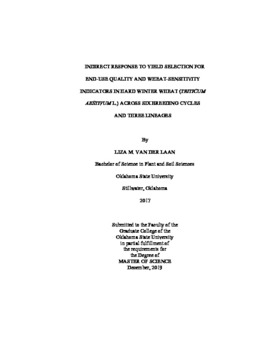| dc.contributor.advisor | Carver, Brett | |
| dc.contributor.author | Van der Laan, Liza M. | |
| dc.date.accessioned | 2020-06-29T17:39:36Z | |
| dc.date.available | 2020-06-29T17:39:36Z | |
| dc.date.issued | 2019-12 | |
| dc.identifier.uri | https://hdl.handle.net/11244/324918 | |
| dc.description.abstract | A rising global population necessitates continued genetic improvement of wheat (Triticum aestivum L.), but not without oversight of intended and untended consequences along the way. This oversight is partly to blame for emergence of the bilateral "gluten crisis" spreading among users and consumers of wheat, albeit from different perspectives. The objectives were to re-establish trends of genetic progress in agronomic and milling traits using a generational yardstick as the timeline, and then use the same yardstick to measure direct and indirect responses in gluten and dough quality and in human wheat-sensitivity indicators. Randomized complete block design field experiments were conducted using 30 released and experimental cultivars spanning six breeding cycles and three distinct lineages descending from Turkey, the common ancestor for hard red winter wheat. Trials were grown in six site-years, and all reported results were derived from at minimum four site-years. Grain yield and kernel size showed a stepwise increase over cycles, with no evidence of a plateau. With the 77% total increase in grain yield, grain protein content decreased by one percentage point. Examination of protein-yield relationships indicated this protein loss was partly due to a dilution effect in higher-yielding environments. The reduced protein content, however, did not result in lower dough strength pertinent to bread baking applications. A novel method of directly testing gluten elasticity via the compression-recovery test indicated a general increase in gluten strength, though anomalies in certain cultivars were clearly evident. The ratio of total polymeric (glutenins) to total monomeric (gliadins) proteins remained stable across cycles. Also showing no change with genetic progress in yield was the level of a specific immunotoxic gluten fragment resident in a-gliadin 2, measured by the gluten G12 assay. The significant genetic variance found among contemporary cultivars signaled the possibility of further reduction without a yield penalty. The oligosaccharide, fructan, present in milled and wholemeal flours increased with increasing grain yield potential. Significant genetic variability was found among contemporary cultivars, giving breeders the necessary resource to support future fructan breeding goals. The gluten crisis appears unfounded, although the rise in fructans does implicate new dietary concerns. | |
| dc.format | application/pdf | |
| dc.language | en_US | |
| dc.rights | Copyright is held by the author who has granted the Oklahoma State University Library the non-exclusive right to share this material in its institutional repository. Contact Digital Library Services at lib-dls@okstate.edu or 405-744-9161 for the permission policy on the use, reproduction or distribution of this material. | |
| dc.title | Indirect response to yield selection for end-use quality and wheat-sensitivity indicators in hard winter wheat (Triticum aestivum L.) across six breeding cycles and three lineages | |
| dc.contributor.committeeMember | Hunger, Robert | |
| dc.contributor.committeeMember | Goad, Carla | |
| osu.filename | VanderLaan_okstate_0664M_16510.pdf | |
| osu.accesstype | Open Access | |
| dc.type.genre | Thesis | |
| dc.type.material | Text | |
| dc.subject.keywords | fructan | |
| dc.subject.keywords | gliadin | |
| dc.subject.keywords | gluten | |
| dc.subject.keywords | historic panel | |
| dc.subject.keywords | wheat | |
| thesis.degree.discipline | Plant and Soil Sciences | |
| thesis.degree.grantor | Oklahoma State University | |
